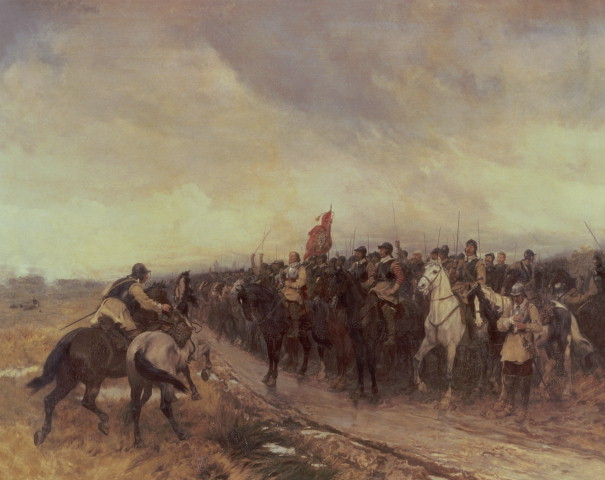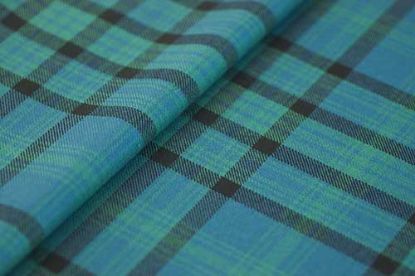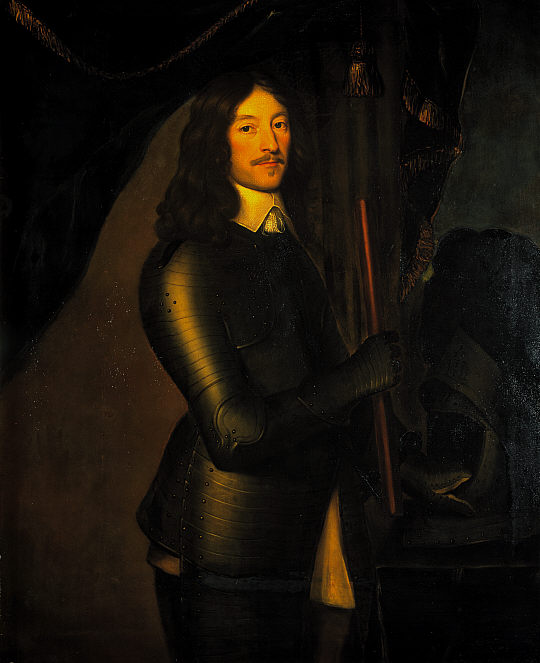1st September 1644 Battle of Tippermuir
The Scottish Government, having embraced the Covenanter Cause, entered the English Civil War and, as a result, King Charles I appointed the ever loyal James Graham, 1st Marquis of Montrose, as his Scottish commander. Montrose thereafter embarked upon a triumphant campaign in which he and his followers were often heavily outnumbered. Assisted by his Clan Donald henchman Alasdair MacColla and his Irish soldiers, he engaged with a substantial Government army near Perth and strategically routed the enemy, who were led by Lord Elcho and James Murray of Gask.
13th September 1644 Battle of Aberdeen
After his victory at Tippermuir, Montrose marched his men on Aberdeen, but the town's civic leaders refused to surrender. Montrose's drummer was killed by a sniper which sufficiently angered him to order an attack, whereupon the Covenanters were defeated and fled.
2nd February 1645 Battle of Inverlochy
Having returned from a recruitment drive on the west coast, Alasdair MacColla persuaded the Marquis of Montrose to attack the clan lands of the Marquis of Argyll, Chief of Clan Campbell and leader of the Government in Scotland. On his approach, however, Montrose received information that the Campbell forces had joined the Covenanting army at Inverlochy. Instead of taking his men on the direct route past Loch Lochy, he therefore decided to go over the mountain range of Allt Na Larach to Glen Roy, where his men were unlikely to be seen. It was an amazing feat of physical achievement resulting in their taking the enemy entirely by surprise, In the ensuing slaughter, the climax of which was a Royalist charge, over 1,500 Covenanters were killed.
James Graham, 1st Marquess of Montrose, Willem van Honthorst (1594 - 1666). Oil on canvas c. 1647 |
9th May 1645 Battle of Auldearn
Having attempted to capture Dundee, James Graham, 1st Marquis of Montrose marched his men north where, at Auldearn in Nairnshire, the Covenanter Commander Sir John Hurry attempted to surprise him. The Royalist Scots, however, were not to be defeated, and Sir John, and those of his men who survived, sought refuge in Inverness.
2nd July 1645 Battle of Alford
After the Battle of Auldearn, the 1st Marquis of Montrose continued to raid Highland supporters of the Covenant and, fearing a second attack on Aberdeen, Major General William Baillie, now in charge of the Covenanting army, set out to intercept him. The two armies were of equivalent strength, although the Covenanters had superior horse power. The Royalist army positioned itself overlooking Alford and, in order to attack, the Covenanters were obliged to cross the river. Montrose waited until the enemy horses had crossed, and began his attack while the infantry were mid-stream. In the ensuing carnage, the Covenanters lost three quarters of their foot soldiers.
16th August 1645 Battle of Kilsyth
His resignation having been rejected by the Covenanting leaders, Major General William Baillie wasted no time in supplementing his army with a fresh intake of soldiers. When Montrose was advised of enemy reinforcements being supplied by Lord Lanark, brother of the 1st Duke of Hamilton, he decided to move between the two forces. Baillie sought to confront Montrose at Colzium, and once again over three quarters of the Covenanter troops fell in the ensuing carnage.
12th June 1648 Battle of Mauchline Moor
This minor confrontation was fought between covenanters opposed to the Engagement and government forces. Although there were remarkably few casualties, the day was won by the Royalists who were led by John Middleton, later created Earl of Middleton, and James Livingston, Earl of Callendar.
17th - 19th August 1648 Battle of Preston
A Scots army under the 1st Duke of Hamilton, who had switched allegiance from the parliamentary party to Charles I, invaded England and, although greatly outnumbering the enemy, was defeated by Oliver Cromwell in Lancashire. Hamilton was taken prisoner and later executed.
27th April 1650 Battle of Carbisdale
The execution of Charles I by the English Parliament reverberated around Scotland while his exiled son Charles II embarked upon a political game. He appointed the 1st Marquis of Montrose his Captain General and Lord Governor of Scotland while at the same time negotiating with the Covenanters.
Using Kirkwall on Orkney as his base, Montrose sent Major General Sir John Hurry, who had previously opposed him, but who had now joined the Royalist supporters, across the Pentland Firth to Thurso. Montrose followed later with several hundred Scandinavian mercenaries, expecting several of the Highland clans to rally to his side, but they did not. At Carbisdale, the Royalist army met the Covenanter army under Lieutenant Colonel Archibald Strachan, and were overwhelmed. Montrose escaped the battlefield, but was betrayed a few days later. He was taken to Edinburgh where he was sentenced to death and executed. On 1st May, Charles II disowned Montrose when he signed the Treaty of Breda in the Netherlands. Having accepted the Protestant Faith, he landed in Moray on 23rd June to sign the Covenant.
 |
Cromwell at Dunbar, Andrew Carrick Gow (1848-1920). Oil on Canvas 1886 |
3rd September 1650 Battle of Dunbar
Infuriated by the Scottish parliament's negotiations with Charles II, the English parliament ordered Oliver Cromwell to invade Scotland, with John Lambert as his second-in-command. The English army crossed the Border in July, but the Scots at first adopted a scorched earth policy. In September, convinced that the English were planning to retreat, the Scottish commander David Leslie marched on Dunbar where he planned to intercept Cromwell's men. Cromwell, suspecting this, re-positioned his men at night and the following day won a resounding victory south of the town.
3rd September 1651 Battle of Worcester
On 1st January 1651, Charles was crowned King of Scots at Scone and, with the Scottish Covenanting army now supporting him, he circumnavigated Cromwell's army to march south into England. When English Royalists failed to rally to his cause, he was overwhelmingly defeated at Worcester. Charles then went into hiding before escaping to France and exile in Holland.
20th July 1651 Battle of Inverkeithing
After Dunbar, Cromwell and his army moved north into Scotland but were checked by David Leslie at Stirling. To overcome this, Cromwell gave instructions to General John Lambert for a naval invasion of Fife across the Firth of Forth from South Queensferry. Once it had landed, the Scots were driven back and overwhelmed.
19th July 1654 Battle of Dalnspidal
A force of clansmen from Clan Gregor was raised in support of the Royalist Cause by the 9th Earl of Glencairn. In July, under the Earl of Middleton, it was confronted by Sir Thomas Morgan, the Lord Protector Cromwell's Commander in Chief in Scotland, near Loch Garry on the Drumochter Pass. Faced with superior numbers, the Royalist soldiers rapidly dispersed.
26th November 1666 Battle of Rullion Green
Following the Restoration of Charles II in 1660, the Scottish Government revealed plans to restore Episcopacy which caused outrage among its Scottish Presbyterian supporters. In the Pentland Hills, near Edinburgh, a small party of rebellious Covenanters were intercepted and massacred by the Royalist General Tam Dalyell of the Binns. Over 1,000 prisoners were incarcerated in the churchyard of Greyfriars in Edinburgh.
1st June 1679 Battle of Drumclog
On hearing that a large Conventicle of Covenanters (a Presbyterian religious service held out-of-doors) was to be held near Kilmarnock Hill in Ayrshire, the Episcopal James Graham of Claverhouse, who had been appointed to put down such seditious gatherings by Charles II, set off to disperse them. His dragoons, however, became stuck in wet marshland and suffered significant losses.
22nd June 1679 Battle of Bothwell Brigg
James, Duke of Monmouth, natural son of Charles II, was the commander of a government force which, despite being heavily outnumbered, succeeded in dispersing the Covenanter army in Lanarkshire. Assisted by James Graham of Claverhouse (later created Viscount Dundee), this effectively dismembered the Covenanting movement, but failed to put a stop to the outlawed Conventicles.
22nd July 1680 Battle of Airds Moss
While a party of Covenanters led by the Reverend Richard Cameron was at worship near Cumnock, they were surrounded and slaughtered by a troop of Dragoons.
August 1688 Battle of Mulroy (otherwise known as the Battle of Maol Ruadh).
A territorial battle over the district of Lochaber which took place near Spean Bridge between the tribal conurbation of Clan Chattan, led my Lachlan Mackintosh of Torcastle, and Clan Cameron and the MacDonalds of Keppoch. A Commission of Fire and Sword had been issued against Keppoch, but when Mackintosh supported by Kenneth Mackenzie of Suddie attempted to reinforce it, they were strongly repelled by a force which included the MacMartins, a sept of Clan Cameron.
27th July 1689 Battle of Killiecrankie
The invasion of the Protestant William of Orange and the exile of the Catholic James VIII (II of England) had divided Scotland politically. While the majority of the Catholic and Episcopalian Highlanders remained loyal to the Royal House of Stuart, the largely Presbyterian Lowlanders of Scotland welcomed William and his Protestant wife Mary, James VIII's daughter. When William and Mary landed in England, James Graham of Claverhouse (now Viscount Dundee), rode north into Perthshire to raise a Highland army in support of the Jacobite Cause. The Government army was commanded by General Hugh Mackay of Scourie and, marching to relieve the siege of Blair Castle, the two armies met at the Pass of Killiecrankie. The Government troops were routed and dispersed, but Viscount Dundee was killed in battle.
21st August 1689 Siege of Dunkeld
In the aftermath of Killiecrankie, a violent skirmish took place at Dunkeld which ended in virtually the entire destruction of the town. Government troops under the command of Lieutenant Colonel William Cleland, a survivor of Drumclog and Bothwell Brig, occupied the town, and were fiercely attacked by the remnants of Dundee's army. It was a savage confrontation which ended when the the exhausted Highlanders fell back from whence they came.
1st May 1690 Battle of Cromdale
Near Grantown-on-Spey, a large Government army under Sir Thomas Livingston, Commander of the garrison at Inverness, encountered the Jacobite army under General Buchan. The Jacobites comprised soldiers from Clan Donald, Clan Cameron, Clan MacLean, Clan Macpherson and Clan Grant under Colonel Cannon, but were surprised with a cavalry attack and dispersed into the surrounding hills.

























